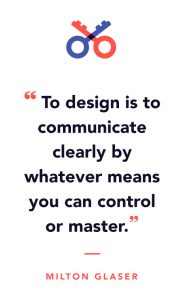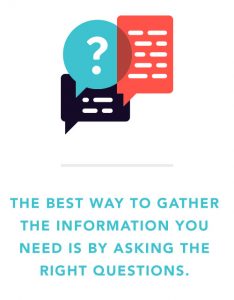
7 min read
Creating a Creative Culture & 10 Human-Centered Design Questions Every Product Team Needs to Ask
Human-centered design should be at the heart of the entire product development process. It should define the structure and philosophy behind every design, development, and business decision related to the product.
What Is Human-Centered Design?
Human-centered design, or user-centered design, is the process of creating products with human psychology and user perception in mind. It is careful, assumption-free design, informed by testing and analysis of real-life experiences. Human-centered design thinking is carried out to have a specific impact on the people using it.
Demographics, values, and context all impact how people interact with a product. With human-centered design, behaviors and traits of the people using the product drive its shape, form, and features. The human-centered design approach is critical to creating products that people will use and includes:
- Improvement or simplification of user experience
- Creation of an intuitive user experience
- Brand enhancement
- Increase in operational efficiency for internal software
Human-Centered Design: Not Just for Designers

While the word “design” often brings to mind a product’s look and feel, design is not just about making a product pretty. For a product to be truly human-centered, everything from the interface to the features and functionality must be built with the user in mind.
Because human-centered design thinking encompasses every aspect of product development, everyone involved in creating the product must orient their work and goals around the user experience.
“Designers and engineers are partners in experience design and should be working in lockstep, holding each other accountable for every decision: Is this what’s best for our users? Is this the best product experience we can provide?” – Victor Rodriguez, UX Designer at Praxent
Engineers tend to focus on performance, while designers focus on delighting the people using the product. Both are needed, and the best products are created when the two work together and achieve balance under the umbrella of a human-centered design approach.
The User’s Experience is the Most Important Experience
A brand goes beyond a company’s logo, taglines, and marketing. A company builds a brand by creating meaningful interactions with its audience at all touchpoints, both digital and physical. Human-centered design, then, ensures customers have a flawless brand experience that truly conveys the value the company has to offer.
The worst possible outcome in a product development project isn’t when the client notices a bug or when beta testers identify an issue. The worst-case scenario is when a significant error hinders the end user’s experience.The impact on a company’s reputation and future success may be profound and immediate. Customers could move on and order from a competitor, close the website, or delete the mobile application.
The user’s experience is the most important experience. It has the most far-reaching effects on the financial success of all product stakeholders.
Although hugely important, keeping the user’s experience front-of-mind is not easy. Yet teams who manage to focus on the humans on the other side of their interface have the healthiest outlooks on product development. They will be the least likely to run off course for the sake of short-term relief or requirements that seem important at the time, but fail to matter when the product gets in front of the user.
>> Learn about our UX design services and how we reduce the risk of product failure with ClickModel™ and user-tested software prototyping.
Creating a Creative Culture with Human-Centered Design Thinking
If a product development team really wants to capitalize on the benefits of human-centered design, their number one challenge will be overcoming the collective view that design and development belong in their own separate compartments. Every developer, designer, project manager, client, or team member who impacts how a user engages with and perceives a product is a “designer.”
This means creating a culture where everyone is design-empowered. At Praxent, we create a feedback loop with users and internal team members at every stage of a project. We ask the business analysts, the solution architects, the product and project managers, and the developers to provide input at each design milestone, including user research, business strategy, workflows, wireframes, comps and prototypes. We also combine human-centered design with design thinking.
Aligning On An End-User Vision: 10 Questions Every Team Member Should Ask
 It’s important to understand at the onset what problem a website or a piece of software is being designed to solve, as well as the intention. Once you determine a path forward, start considering what users want out of the end product. The best way to gather the information you need to make good decisions is by asking the right questions. Focus discussion around human-centered design questions that inspire user empathy.
It’s important to understand at the onset what problem a website or a piece of software is being designed to solve, as well as the intention. Once you determine a path forward, start considering what users want out of the end product. The best way to gather the information you need to make good decisions is by asking the right questions. Focus discussion around human-centered design questions that inspire user empathy.
- What is the need for this product? Does what we’re building target that need?
- In what context or environment will this product be used?
- What is the journey like for a person using this product? How and why did they arrive at using the product?
- What is our product vision? Is this an MVP or something for future release?
- What constraints, challenges and opportunities exist in the development, design and usage of this product?
- Have we built and designed the product in a way that it is reasonably easy for someone to learn how to use it?
- Is the product accessible to those with various disabilities?
- Can the necessary digital platforms and environments support the product software?
- Does the product effectively and efficiently help users accomplish the tasks they’re using it for?
- Who will core users of the product be? Who will casual users be? What are the differences in behavior and the context in which they will be using the product?
In order to be effective and achieve human-centered design, you need to ask questions and ensure alignment on several items. The following items are essential to the human-centered approach:
- Collaborate on all levels
- Use prototypes early
- Keep testing and incorporating feedback
- Increase your chances for software success
Reaping the Benefits of Human-Centered Design
Users aren’t the only ones who benefit from human-centered design. Companies selling user-focused products enjoy greater profit, and teams who implement human-centered design experience positive changes in the way they operate. As product users are given center stage, potential for short-sighted decision-making is mitigated by a balanced vision of the bigger picture.
Human-centered design thinking leads to products that fit seamlessly into the lives of those who use them. It’s not only the key to thoughtful digital products, it’s the oil in the product development machine. Factoring the end users into the design equation allows for the creation of something truly meaningful.


Leave a Reply